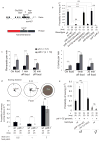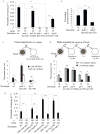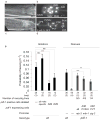PDF-1 neuropeptide signaling modulates a neural circuit for mate-searching behavior in C. elegans
- PMID: 23143519
- PMCID: PMC3509246
- DOI: 10.1038/nn.3253
PDF-1 neuropeptide signaling modulates a neural circuit for mate-searching behavior in C. elegans
Abstract
Appetitive behaviors require complex decision making that involves the integration of environmental stimuli and physiological needs. C. elegans mate searching is a male-specific exploratory behavior regulated by two competing needs: food and reproductive appetite. We found that the pigment dispersing factor receptor (PDFR-1) modulates the circuit that encodes the male reproductive drive that promotes male exploration following mate deprivation. PDFR-1 and its ligand, PDF-1, stimulated mate searching in the male, but not in the hermaphrodite. pdf-1 was required in the gender-shared interneuron AIM, and the receptor acted in internal and external environment-sensing neurons of the shared nervous system (URY, PQR and PHA) to produce mate-searching behavior. Thus, the pdf-1 and pdfr-1 pathway functions in non-sex-specific neurons to produce a male-specific, goal-oriented exploratory behavior. Our results indicate that secretin neuropeptidergic signaling is involved in regulating motivational internal states.
Figures





References
-
- Pfaff DW. The Physiological mechanisms of motivation. Springer Verlag; 1982.
-
- von Frisch O. Animal migration. HarperCollins; 1969.
-
- Reppert SM. A Colorful Model of the Circadian Clock. Cell. 2006;124:233–236. - PubMed
-
- Bendesky A, Bargmann CI. Genetic contributions to behavioural diversity at the gene-environment interface. Nat Rev Genet. 2011;12:809–820. - PubMed
Publication types
MeSH terms
Substances
Grants and funding
LinkOut - more resources
Full Text Sources
Research Materials

